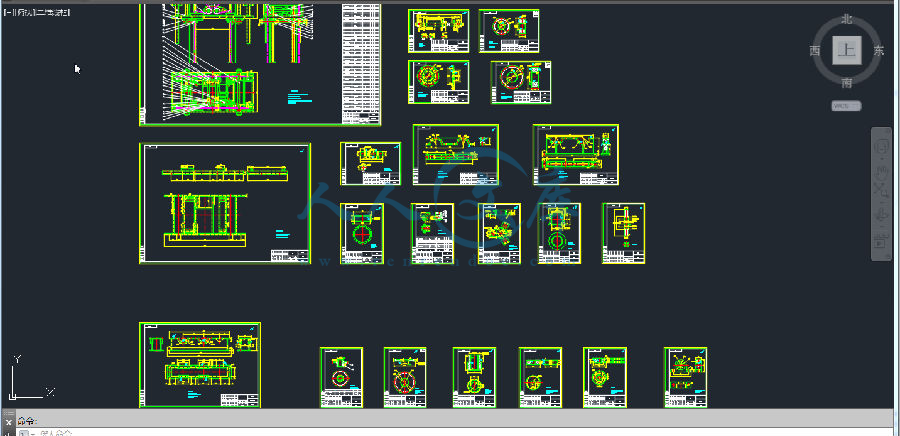摘要
现在,码坯机主要由切条机、切坯机、分坯机、夹盘机构、行走机构、升降机构、旋转机构和电气系统等组成。其中升降机构是其中一个重要部分,现在升降机构一般采用液压升降与滚子链升降两种方法。液压升降因为液压元件的制造精度要求较高、价格较贵,而且不能得到严格的传动比、效率较低。又由于工作性能易受到温度变化的影响,因此不宜在很高或很低的温度条件下工作,所以设计采用滚子链升降。升降采用滚子链,使其运动准确,避免打滑现象,同时利用四个导向柱,增加设备的稳定性。滚子链由大小链轮带动,共四组,布于四周,通过摆线针轮减速机通过齿轮箱带动两根轴实现同步上升。最后在车架两端加上配重,通过钢丝绳与夹盘机构连接,这样可以减轻滚子链受力,减小功率。行走机构通过另一摆线针轮减速机带动行走轴行走。此为本文设计方案,并且通过计算,论证了该设计方案的可行性。
关键词:码坯机;升降机构;行走机构;滚子链升降
Abstract
Now, setting machine is mainly composed of a cutting machine, cutting machine, cutter, chuck mechanism, running mechanism, lifting mechanism, a rotating mechanism and electrical system. The lifting mechanism is one of the most important parts, now lifting mechanism generally adopt hydraulic lifting and roller chain lifting two methods. Hydraulic lift for hydraulic components of the manufacturing precision is high, the price is more expensive, but can not be a strict transmission ratio, low efficiency. Because the working performance are susceptible to the influence of temperature change, therefore not at very high or very low temperature conditions, so the design of the roller chain lifting. Lifting the roller chain, the motion accuracy, avoid the slip phenomenon, at the same time using four guide posts, increases the stability of equipment. Roller chain sprocket drive by size, a total of four groups, the cloth around, through the cycloidal pinwheel speed reducer through the gear box drives two axis synchronous rise. In the final frame ends with counterweight, through the steel wire rope and the chuck body connected, this can reduce roller chain stress, reduce power. Walking mechanism through another cycloid reducer drive shaft walk walking. This is the design, and through calculation, it proves the feasibility of design scheme.
Key words :Setting machine; lifting mechanism; running mechanism; the roller chain lifter
目录
1 绪论1
1.1 砖瓦工业的现状1
1.2 码坯机在国内的发展现状1
1.3 码坯机的概述2
2 机构工作原理与方案的确定3
2.1 机构的工作原理3
2.2 机构方案的确定3
3 运动与动力参数的计算4
3.1 机构传动简图4
3.2 减速器及电机的选择4
3.3 传动比分配6
3.4 各轴的转速计算6
4 齿轮传动的设计计算6
4.1 升降机构齿轮设计计算6
4.2 行走机构齿轮设计计算10
5 轴系零件的设计计算11
5.1 升降轴的设计11
5.1.1 升降轴的结构设计11
5.1.2 行走轴的结构设计13
6 轴上键连接的选择及校核14
6.1 升降轴上键的选择及校核14
6.2 行走轴上键的选择及校核14
7 滚动轴承的选择及校核15
8 齿轮箱及双联轴承座的设计16
9 链轮与链条的设计16
10 车架的设计16
参考文献18
致谢19
1 绪论
1.1 砖瓦工业的现状
砖瓦作为房屋建筑最基本、最古老的材料在我国房屋建筑中有着非常重要的历史。众所周知,我国是世界上砖瓦生产第一大国,进入21世纪以来,每年砖瓦产量8100亿块,其中粘土实心砖4800亿块以上,空心砖和多孔砖1700亿块以上,煤矸石、粉煤灰等多种废渣砖1600亿块以上。砖瓦生产的第一大国,必然在砖瓦生产能耗上也是第一大国。
当前我国正处在全面建设小康社会的重要时期,城市化步伐不断加快,建筑业和房地产业成为拉动国民经济增长的主要源动力之一。建筑业的持续增长,特别是新农村建设促使广大农村建筑需求的增长,将继续为砖瓦工业的发展提供广阔的市场空间。 在农村住房消费方面,“十一五”规划提出了新农村建设的重大战略任务和目标。毫无疑问,随着新农村建设不断发展,农村房屋建设无论是数量,还是结构、功能、质量,都将出现新的变化,对砖瓦和其他墙体屋面材料需求的拉动力将非常巨大。
因此,完全可以相信,在未来相当长一个时期,随着城乡建筑业的发展,砖瓦工业仍然有着巨大的市场发展空间。





 川公网安备: 51019002004831号
川公网安备: 51019002004831号